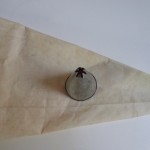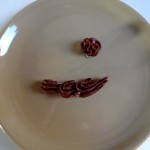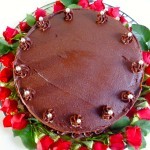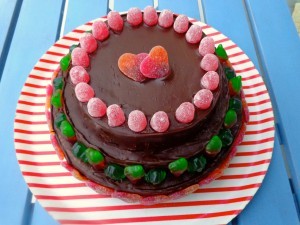Decorated chocolate cake
This cake can be as elaborate or as simple as you like. It’s a chocolate genoise, sliced into layers and spread with a rich chocolate buttercream icing, with jam and more icing spread between the layers to create a delightful confection that always makes a hit at parties.
The recipe below is for a cake that will serve 12 people. It requires an 8-inch (20-cm) spring-form pan, or two 8-inch (20-cm) cake pans, or one 10-inch (25-cm) cake pan. For a larger tiered cake, double the recipe and use pans of differing sizes. The baking time will depend on the depth of the pans you use.
 For the decoration, you may use a pastry (piping) bag with a star-shaped tip or use candy, or even flowers, which create an unusually beautiful effect. The icing recipe is generous to ensure there’s enough if you decorate with icing. If there’s more than you need, you can freeze it for another occasion.
For the decoration, you may use a pastry (piping) bag with a star-shaped tip or use candy, or even flowers, which create an unusually beautiful effect. The icing recipe is generous to ensure there’s enough if you decorate with icing. If there’s more than you need, you can freeze it for another occasion.
Equipment mentioned in the recipe also includes: an electric beater, a wire whip, a pastry brush, a sieve, a rubber spatula, a wire rack, a double-boiler, a metal spatula, a cake platter. If you are lacking any of the above, simply improvise with what you have on hand.
For the cake:
6 eggs at room temperature
1/4 pound (125 g) unsalted butter at room temperature
1 cup (200 g) sugar
1/2 cup (65 g) flour, plus a little extra for the cake pans
1/2 cup (75 g) high-quality unsweetened cocoa
For the icing and filling:
2 eggs at room temperature
1/2 pound (250 g) unsalted butter at room temperature
7 ounces (200 g) sweetened dark chocolate
1 tsp. strong black coffee
1 tsp. plus 1 tbsp. cognac (brandy) or rum
2/3 cup jam: blackberry, black currant, red currant, raspberry or plum
Begin by making the cake:
Separate 6 eggs into two bowls — a large bowl for the whites and a medium-sized bowl for the yolks.
Melt 1/4 pound (125 g) butter in a saucepan. Turn off the heat.
Prepare your cake pan or pans: Using a pastry brush if you have one, or a paper towel if not, coat the bottom and sides of the cake pan(s) with a thin layer of melted butter. Sprinkle each pan with 1 tbsp. flour and shake the pan to spread it around evenly. Give the pan a few sharp taps over the sink to knock out the extra flour.
Measure out the rest of the flour — 1/2 cup, or 65 grams — and transfer to a third bowl. Add the cocoa to the bowl.
Preheat the oven to gas mark 6 (350 F, 180 C).
Using a wire whip, beat the yolks until they are smoothly blended.
Using an electric beater, beat the egg whites until they are firm. Add the sugar all at once. Continue beating until the whites form very stiff peaks. It’s important that they be very firm because there is no leavening in this cake — the whites are what will make it rise.
Add about 1/3 of the whites to the yolks. Mix in with your wire whip in to lighten the yolks.
Now add the lightened yolks back into the whites. Fold in very gently using a rubber spatula, turning the bowl a quarter-circle after each fold to ensure that the batter is smoothly blended.
Pass the flour and cocoa through a sieve onto the batter. I generally use a scoop-shaped sieve and the back of a spoon for this. Fold in with the rubber spatula, again turning the bowl as you go to ensure a smooth mix.
Pour the melted butter onto the batter. Fold in gently with your rubber spatula, turning the bowl as you go.
Turn the batter into your cake pan or pans, and place in the oven. Bake for 20-30 minutes, until the cake has pulled away from the sides of the pan and is firm when you touch it in the middle. Be careful — if you open the oven too soon, the cake could fall.
When the cake is ready, remove it from the oven. Run a knife around the edge. Place a wire rack over the cake and invert. Give the pan a tap, and remove the pan. Allow to cool.
Now make the icing — or you can do this while the cake is baking:
Separate the remaining two eggs, keeping the yolks and discarding the whites.
Melt the chocolate in the top of a double boiler.
If you don’t have strong coffee on hand, make some now.
While the chocolate is melting, beat 1/2 pound (250 g) butter in a large bowl until very smooth, using an electric beater. Add the yolks to the butter and beat again until the mixture is very creamy.
When the chocolate is melted, allow it to cool for five minutes and then add it to the softened butter. Beat only enough to blend. Add 1 tsp. coffee and 1 tsp. cognac or rum. Beat again briefly.
Allow the icing to cool for 10 minutes before beginning to ice the cake.
During this interval, slice the cake in half or thirds horizontally. I find that the best way to do this is using a serrated bread knife. Insert the teeth of the knife into the edge of the cake and turn to make a small incision all the way round. Then, very gently, increase the pressure on the knife so that it gradually goes through the entire cake.
Place the jam in a small bowl and stir to loosen it up.
Place the bottom layer of the cake on your wire rack, setting the other layer or layers aside. Sprinkle with cognac or rum. Spoon on some icing and spread to cover the surface. Spoon on some jam and spread over the icing.
Place the next layer on top. Sprinkle with cognac or rum. If this is the top layer, go on to the next step. If it’s the middle layer, cover it with icing and jam as described above, and set the final layer on top.
Now comes the tricky part. Spoon quite a bit of icing on top of the cake. Using a metal spatula, spread it around so that it tips over the edge. Hold your spatula in a vertical position and spread the icing around the sides of the cake. If you need more, add it to the center of the cake and work it across and over the edge.
You are aiming to achieve a smooth finish to the top and sides of the cake. This can take some time, so be patient. For the final smoothing, clean off your spatula and heat it under hot running water. Dry it off and run it over the top and sides of the cake.
When you are satisfied, place the cake in the fridge to cool, wire rack and all. Leave the additional icing out in the kitchen at room temperature.
When the cake has chilled for about 10 minutes, remove it from the fridge and transfer it onto a cake platter. Smooth over any rough spots with additional icing as necessary.
If you are decorating the cake with candy, do that now. Press the candy into the sides of the cake so it will hold, and refrigerate until ready to serve.
 If you are decorating the cake with icing, spoon the remaining icing into a pastry (piping) bag fitted with a star-shaped tip. Press the icing down to the bottom and fold the bag over itself to make a tight fit with no air. Moving around the bottom of the cake, create little waves of icing that fold over each other.
If you are decorating the cake with icing, spoon the remaining icing into a pastry (piping) bag fitted with a star-shaped tip. Press the icing down to the bottom and fold the bag over itself to make a tight fit with no air. Moving around the bottom of the cake, create little waves of icing that fold over each other.
You can repeat this on the top of the cake, or make star-shaped dots around the top. Make 12 dots: start at noon, then 6 o’clock, then 3 and 9, and then fill in the spaces with two dots each. Sometimes I use small silver candy balls all around the top to create a glamorous effect.
 If you are decorating the cake with flowers, wait until the last possible minute and then cut the stems from the flowers and place them around the sides and into the top of the cake. I find that roses are a good choice, but all kinds of flowers can work well — freesia, narcissus, nasturtiums, whatever.
If you are decorating the cake with flowers, wait until the last possible minute and then cut the stems from the flowers and place them around the sides and into the top of the cake. I find that roses are a good choice, but all kinds of flowers can work well — freesia, narcissus, nasturtiums, whatever.
In each case, refrigerate the cake after decorating until about 10 minutes before you plan to serve it. Bring it to the table, and prepare for applause. Serves 12.





